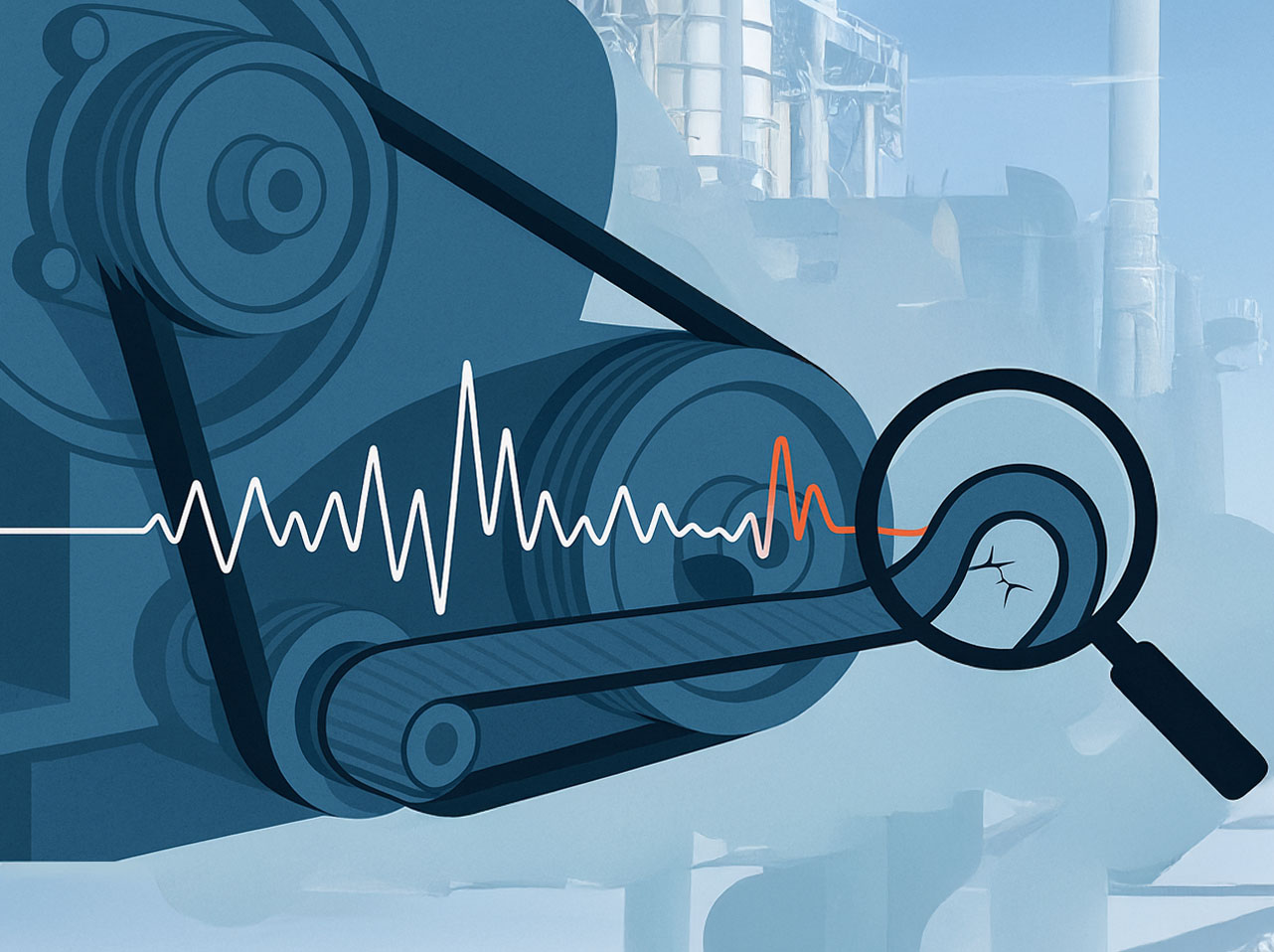Getting Ahead of Belt Failures: Fault Diagnosis with Vibration Analysis
Belt drives are workhorses in countless industrial systems—reliable, low-maintenance, and cost-effective. But when they fail, the consequences are steep: lost production time, equipment damage, and safety hazards. That’s where proactive fault diagnosis and vibration analysis come in.
In this article, we explore how understanding Primary Belt Frequency (PBF) and vibration anomalies helps predict, detect, and prevent belt faults using Erbessd Instruments tools.

Proper Belt Function & Primary Belt Frequency (PBF)
A healthy belt system maintains correct tension, alignment, and friction—ensuring smooth power transmission with minimal vibration, typically at the fundamental 1× running speed. The Primary Belt Frequency is key to this analysis and can be calculated as:
PBF = (shaft RPM ÷ belt length) × pulley circumference (converted to Hz)
Deviations in amplitude or shifts in PBF often signal early-stage issues.
Common Belt Faults – Detection via Vibration Analysis
1. Side Cuts, Cracks & Wear
Damage introduces asymmetries, leading to spikes at harmonics of the belt frequency. A study observed up to 3× greater vibration energy at low frequencies when belts were damaged, especially on horizontally aligned accelerometers.
2. Looseness & Misalignment
Looseness broadens frequency peaks and boosts the 1× component. Misalignment and slipping create sidebands and modulated harmonics—detectable via FFT analysis.
Advanced Fault Prediction with Machine Learning
The 2021 Applied Sciences study by Pollak et al. [Prediction of Belt Drive Faults in Industry 4.0] deployed an adaptive anomaly detection algorithm using vibration data from belt systems. Key features:
- No need for fault-labeled training data—ideal during production.
- Used accelerometers to capture vibrations in multiple axes, analyzed using FFT and spectrograms.
- Enhanced detection reliability with an autoencoder neural network, classifying anomalies with F1 scores > 98%, using both horizontal and vertical sensors.
- Lab tests showed mapping-error thresholds could reliably separate damaged from healthy states (1.5–1.8 % error cutoff).
Erbessd’s WiSER™ accelerometers, paired with DigivibeMX™ software, empower users to:
- Monitor belt vibration non-invasively and in real time
- Track PBF amplitude and harmonic anomalies
- Apply FFT and envelope analysis techniques
- Seamlessly integrate vibration data into predictive maintenance platforms
This combination supports fault detection before failure, eliminating subjective manual inspections.
Risks of belt failure
- Safety Hazards – A sudden belt break under tension can injure personnel or damage machinery.
- Efficiency Loss – Slippage or misalignment increases energy consumption and reduces performance.
- Unplanned Downtime – Even short interruptions can disrupt entire production lines.
Continuous vibration-based monitoring within an Industry 4.0 framework can prevent such risks. Indeed, Pollak et al. note that integrated predictive systems optimize maintenance scheduling, reduce costs, and enhance overall plant reliability.
From Reactive to Predictive: Next Steps
With advanced analytics and AI-assisted diagnostics, vibration-based belt monitoring becomes a smart investment—not just a safety measure. Erbessd Instruments makes these techniques accessible, accurate, and scalable.
Interested in a demo or tailored deployment for your belt systems? Let’s connect—your operations deserve smarter maintenance.
References
- Failure analysis in predictive maintenance: Belt drive diagnostics. Safety Sci., 2024
- Pollak A., Temich S., et al. “Prediction of Belt Drive Faults in Case of Predictive Maintenance in Industry 4.0 Platform.” Applied Sciences, 2021
- Al Bulushi et al., “Fault Diagnosis in Belts using Vibration Monitoring,” IJMSE, 2015
Megh Howard, BSc serves as the Chief Marketing Officer and Director of People & Culture at Erbessd Instruments. This unique combination allows her to unite the company’s outward-facing brand strategy with its internal culture and values—ensuring that how the company shows up for its customers is deeply rooted in how it operates from within.
Megh believes that a strong, people-centered culture is essential to delivering exceptional customer experiences. By fostering an environment where employees feel valued, connected, and empowered, she helps ensure that customer-first values aren’t just part of the marketing message—they’re lived every day across the organization. Her work aligns employee engagement with service excellence, bridging global teams and creating a workplace that mirrors the trust and support Erbessd Instruments extends to its clients and partners.
A graduate of Hudson Valley Community College and Penn State University, Megh brings a thoughtful, relationship-driven approach to leadership—connecting with colleagues, customers, distributors, and industry peers with authenticity and purpose.


